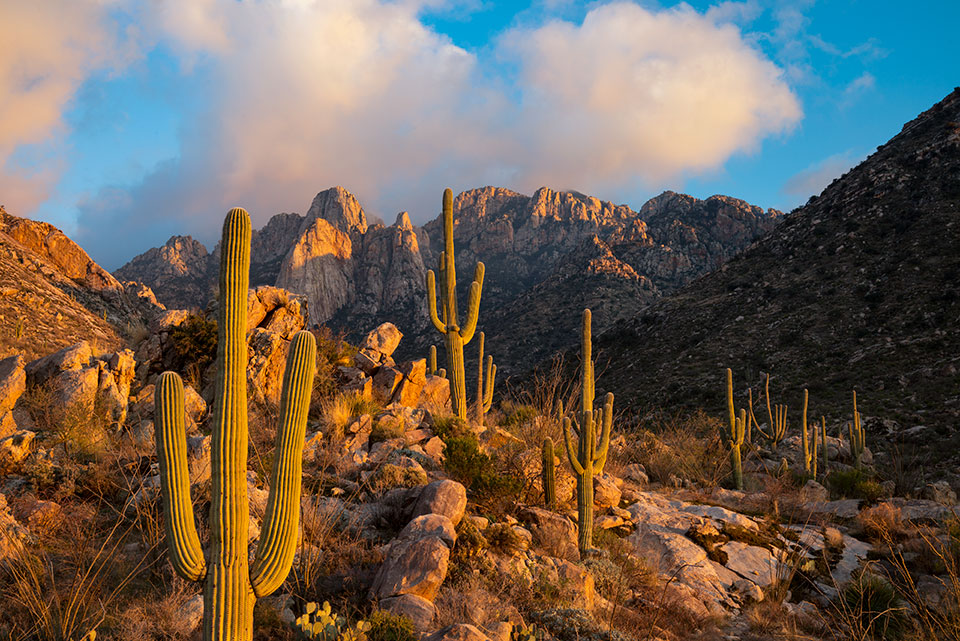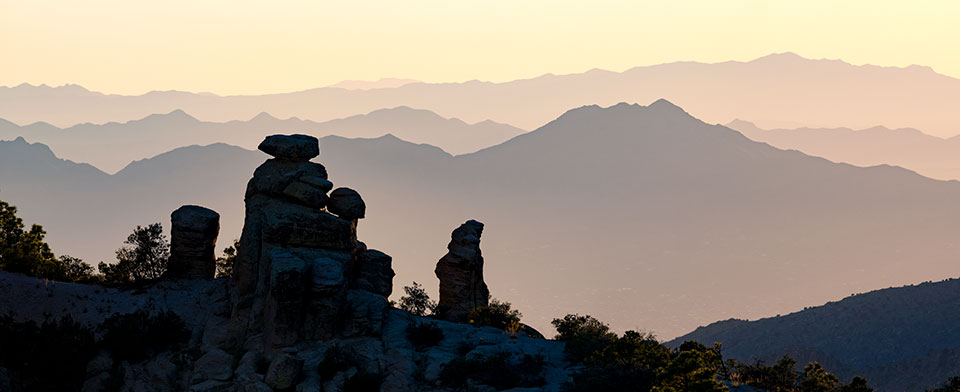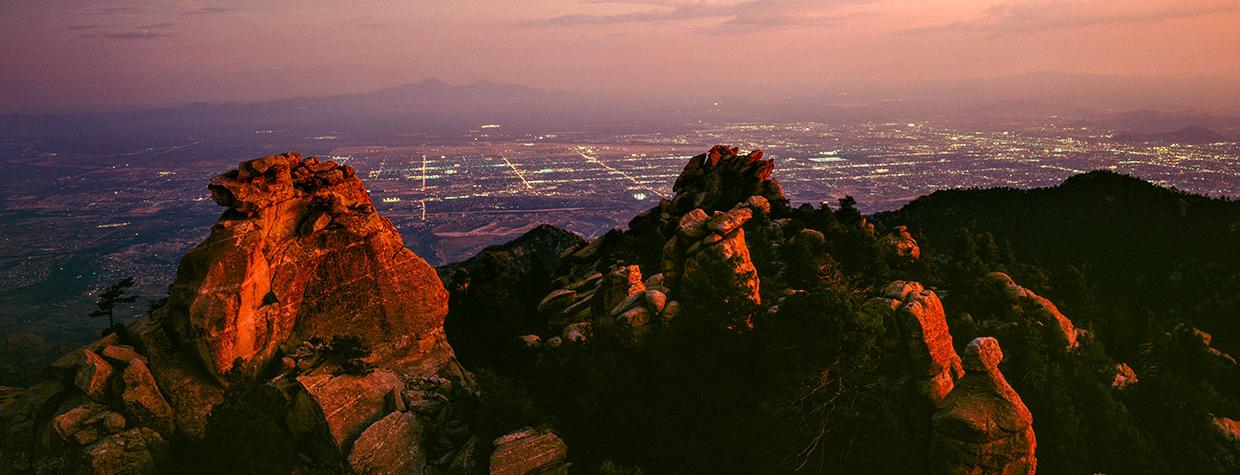Editor's Note: This article was originally published in the September 1985 issue of Arizona Highways.
WE BED DOWN IN DAN SADDLE where the world of oak meets the world of pine. A big alligator juniper anchors the camp. At 6,000 feet a soft breeze slips through the slot between the big canyons that rake the north flanks of the Santa Catalinas. At midnight a deer minces across the moonstruck meadow. Just over the main ridge of the range, a half-million people live — sprawling across the Santa Cruz Valley in the city of Tucson. That does not matter here. We have walked more than ten miles since dawn and have seen no one.
The mountain offers a loneliness of form. At sunset the range sinks into blades of color. Light pours across the slopes; the greens bite the golds; the blues seep into a growing blackness. On the ground near my head a bird thrashes, its rust sides throbbing against the carpet of brown oak leaves. The failing rays caress Cañada del Oro just to the west as the green gouge slides off the peaks and into the brown desert below. The big hole looks inviting, a simple walk from side to side.
I remember this verdant world as the night blankets the camp with the fury of the stars. For most of my life, the Catalinas have greeted me at sunrise and beckoned with canyons and ridges.
They make an easy offer, but they drive a hard bargain.
In 1871 Isaac Goldberg meets a former Apache captive in Tucson who tells him big chunks of gold are scattered at the head of the Cañada del Oro. Goldberg organizes a party of a dozen or more and follows the man to the bonanza. They find chunks of mica. Goldberg decides he wants to go home to Tucson. Eight days later, the starving party stumbles out of the range. He writes, “almost incredible hardships attended and encumbered our progress homeward — narrow steep trails between dreadful abysses, exhausting tracts of rocky sterility, and patches of brush so thick and thorny that our weary bodies lost their coverings, and our blistered feet their leather protectors. We were nearly naked, barefoot, and on the very brink of starvation, for we had not food except a small quantity of pinole and some wild grapes. ...”
In the dark night I sip cocoa and eye the frenzy of energy in the sky. The breeze whispers in the trees, and the deer walk between our sleeping forms.
We are alone; we are surrounded. Three miles up the ridge, a paved road slices through the forest and ends in the resort village of Summerhaven. Nearby a sawmill eats trees. Just below my camp a man once told me of treeing three bears on a lion hunt. To the east bighorn sheep keep watch above a resort complex.
The Catalinas are an island in a growing urban sea. The mountains are the prisoners of the world that feeds me. The island flings back casual efforts to know it and probe it and take it. From the road it is views; from the trail, hard miles. But this night it is rich and complicated and beckoning. The Catalinas are Tucson’s best idea of itself. The range abuts the city, and the city looks at the rock walls and remembers and dreams all the ancient thoughts of freedom. The mountain offers 200 square miles of wilderness next to a city plunging into the Age of the Computer.
Until the late nineteenth century, maps guessed at the general shape of the range. Only after World War I was a road completed on the back side. A thrill for automobile drivers.
“Some of the early big touring cars had to run ahead and back before they could make some of the curves. ... Mud and washing too were a problem during the summer storms, cars would get sideways across the road or, hung in the many drainage gutters against the inside bank. The road was too narrow in many places for safe passing, and so a control system was put into effect on the last seven miles. ... Vehicles waited until time to start up the grade. It was a cozy affair, gave the various drivers time to discuss the affairs of the day, the previous trip, and what they figured the chances of making it this time were. ...”
— Recollection of Glenton G. Sykes
The mountains stand next to a city founded in 1776 yet, for a long time, no one was quite sure how the peaks could be reached. In part, the Apaches scared off some strangers; others the mountain itself sent packing.
We have come to the peaks tracking a man and a woman who sought the summit in 1881. Botanists, their strange journey offers a way to know the beauty of the marvelous Santa Catalina Mountains.
The first naming came easily enough. In 1697 Father Eusebio Kino visited a Papago village near present-day Tucson and named it Santa Catalina Cuitchibaque, perhaps because his arrival coincided with the feast day of St. Catherine. The neighboring mountains got the same name, spelled variously as Caterina and Catalina until the present usage in the late nineteenth century.
John Gill Lemmon and his bride, Sarah Plummer Lemmon, arrived in Tucson in March 1881, looked at the 9,000-foot range, and laid immediate plans to uncover its botanical secrets.
At dawn the sky burns red; cool air hugs the saddle. In the valley it will be 105 today. While eating breakfast, we stare down the hard slope of Oracle Ridge. We know the Lemmons came this way, and we are almost certain they camped here in Dan Saddle. We sense from our experiences they had no easy time of it.
A vulture waits on a rock for the sun to roast the air and create thermals to ride. The trail snakes through manzanita and clumps of cactus flowers flaming red and lavender in a sea of dusty green. Oracle Ridge stretches before us, a natural highway to the summit. The desert floor bakes, and the heat climbs the mountain to slap us in the face.
John Gill Lemmon and his bride of six months struggled on the front range of the Catalinas seeking a route to the green forests high above. Thorns ripped their bodies; heat and lack of water startled them. At night they slept in rock cavities and built fires to keep dreaded snakes, scorpions, and Gila monsters at bay. Day by day they probed an imaginary mountain — one that seemed just minutes away from the train depot, one reputed to be infested with venomous dangers. And day by day, they found the real mountain, one full of hard miles, cliffs, steep slopes, and a botany undreamed of in the ivy towers of Eastern academies.
Saguaro, mesquite, paloverde, and agave dominated the mountain’s lower reaches. Then a bit higher, amole, a fierce small agave known to all human beings on foot as shindaggers, and catsclaw drew blood for every half-mile of advance. They crept higher, every ridge presenting yet another ridge, and the high ridges, sheer cliffs, until finally they surrendered and struggled back to Tucson. There they learned of Emerson Oliver Stratton, a rancher and mine owner living on the slopes of the mountain’s north side. Lemmon arrived at Stratton’s ranch riding a horse, his wife walking behind him.

Stratton, a Western pioneer, was a man on the move, an optimist with dreams of a big strike. He tried bookkeeping in California, moved to Lima, Peru, and opened a roller rink, helped build a railroad in the Andes, manned the stage stop at Maricopa Wells, served as undersheriff of Pinal County, grub- staked prospectors, homesteaded and failed, mined and went bust, bagged political appointments, and just generally kept an eye peeled for the big rock candy mountain. By the time the Lemmons arrived, Stratton had gotten the drift of his life. He called his Southern Arizona ranch Pandora.
Lemmon was not a mountaineer. A survivor of Andersonville Prison in the Civil War, he came home a wreck. After a long twelve months of recovery, he still weighed ninety pounds. “I first groped about the yard,” he wrote later, “upheld by the fence rail. The next day I was able to walk a little way alone, being greatly stimulated by unrecognizable plants. In a few days, I could go further, assisted by my aged mother. ...” An acquaintance pegged him as “nervous and excitable in a very unfortunate way. ...”
Botany pulled him back into the real world. Soon he was wandering the Sierra Nevada in California and snaring new species for Professor Asa Gray of Harvard. By the time he showed up at Stratton’s ranch just below Oracle Ridge in 1881, he was forty-nine years old, his wife, forty-six. Stratton led them to the mountain of their botanical dreams.
We walk the same trail they probably took, overgrown now with manzanita and higher up, oak. A wall of branches six feet high rips at our arms and legs. The path climbs and falls as the ridge rises and buckles beneath us. We pound steadily toward the green peaks ahead.
The birds have gone to ground; the deer rest under trees; the heat of day comes on. By 11:00 a.m. we too collapse under an oak on the shoulder of Apache Peak. We each have drunk three to four quarts of water, and there are still fifteen miles to go.
Below us in an oak valley cottonwoods cluster near the abandoned mining site of Camp Bonito. Here Stratton and the Lemmons spent their first night.
John P. Zimmerman and Sam Parkinson loved the Apache Girl, a mine at Camp Bonito they figured would put them on Easy Street. They were part of a wave of prospectors who slammed against Oracle Ridge in the 1880s and 1890s believing a rock pile that big had to hold a bonanza. They gouged out the vein but soon found their gold mine was little more than a very small gold pocket.
When Fate delivered them a visitor interested in their property, they showed him their dump, liberally salted with gold specimens. Then they led him crashing through the dense oak thickets to a second dump, then a third. Naturally, the three dumps were all the same. But the visitor huffing and puffing up the mountain was too busy to notice. He bought the gold mine. And Zimmerman and Parkinson hit the road.
By 3:00 p.m. we’re on the trail again. We trace the ridge line through oak groves punctuated with huge junipers and then hightail it up Rice Peak on endless switchbacks, only to plunge back into the oak thickets, the branches flailing us into a kind of green serenity. To the right the mountain falls away, the trail at times edging along outcrops. We can see the Cañada del Oro sweeping up to the peaks, a blanket of pine daubed with light-green blaze of aspen. Stratton and the Lemmons dismounted and led their horses on this stretch.
Finally, the slope ebbs, the path wandering down to Dan Saddle, a spot on the ridge between Rice Peak and the top of the range. It’s here on a level patch under the oaks where John Gill Lemmon and Sarah Plummer Lemmon came alive in the late spring of 1881.
“I seized a branch and shouted, ‘All hats off!’ The leaves are in fascicles of five, instead of the threes of the yellow pine, and this character distinguishes the new Pinus Arizonica for which I have so long been in search.”
— John Gill Lemmon at Dan Saddle, 1881
Now the mountain of the scenic calendars begins. The oaks are replaced by pine, and everywhere grass carpets the slopes. Penstemon erupts from the green floor with spikes of red flowers. Alligator junipers, three to six feet thick, line the ridge. Squirrels scurry underfoot, and the eye absorbs the 100-mile views. In minutes we arrive at Summerhaven, a village of summer cabins at an altitude of 7,500 feet. Dogs sleep in front of the general store, and Steller’s jays holler among the big pines. The cafe serves us steak and eggs as we look upon the first people since Oracle, fifteen miles and 3,000 feet below.
Hitchcock Highway zips people up in an hour. Summerhaven has a store, restaurant, and cabins; just up the slopes a ski lodge offers the southernmost runs in the United States. Yet, just 100 yards off the road, the mountain remains wild.
After breakfast we walk up Carter Canyon then bushwhack toward the summit. The cabins fall behind, and the mountain takes us into the shadow of pine and fir and spruce.
Our feet slip; we grab tree trunks as we climb upward.

When Stratton and the Lemmons clambered to the summit, they carved their names into a big tree. Stratton christened the 9,157 foot peak Mount Lemmon after Mrs. Lemmon. The name stuck.
The two botanists found over 100 plants new to science in the Catalinas and later other Arizona ranges. Stratton finally got lucky and peddled a mine site off Oracle Ridge that still bears his name. He built a fine house in San Francisco.
The tree the Lemmons carved their names on went down in the 1920s. In the 1950s, the Air Force put a radar station on the peak, and now this facility houses scientists studying the heavens.
We walk onto the summit at noon. The sky is white light; the ground, lime green. We have come twenty miles and, outside of Summerhaven, we have been alone. We make a cup of cocoa and look north down the big cut of the Cañada del Oro. For almost a century rumors have persisted of an ancient Jesuit gold mine in the canyon.
In 1923 Harold Bell Wright drafts a novel entitled The Mine with the Iron Door. In 1933 another writer says an old Opata Indian named Calistro, who lives in Tumacacori, knows of the mine. Maps float around giving the location. In the 1950s, a Spanish forge is said to be found in the canyon. Like similar legends, no fact will ever stop the story.
The air is thin at 9,000 feet, and the body becomes lazy. I drift into a kind of half-sleep and watch time move slowly across the Cañada del Oro. The Catalinas have been named, mapped, grazed, prospected. No one has ever found the heart of gold.
In the late nineteenth century, an old hermit named Dan Tierney lived in a dugout under Oracle Ridge. He had a mine he never seemed to work. Stratton would drop by from time to time to check on the old man. He always found him sitting on a rock, just staring off at the mountain. Stratton figured this was a damned peculiar way to live.
I watch the vultures swing idly across the Cañada, and I think of Dan Tierney.

